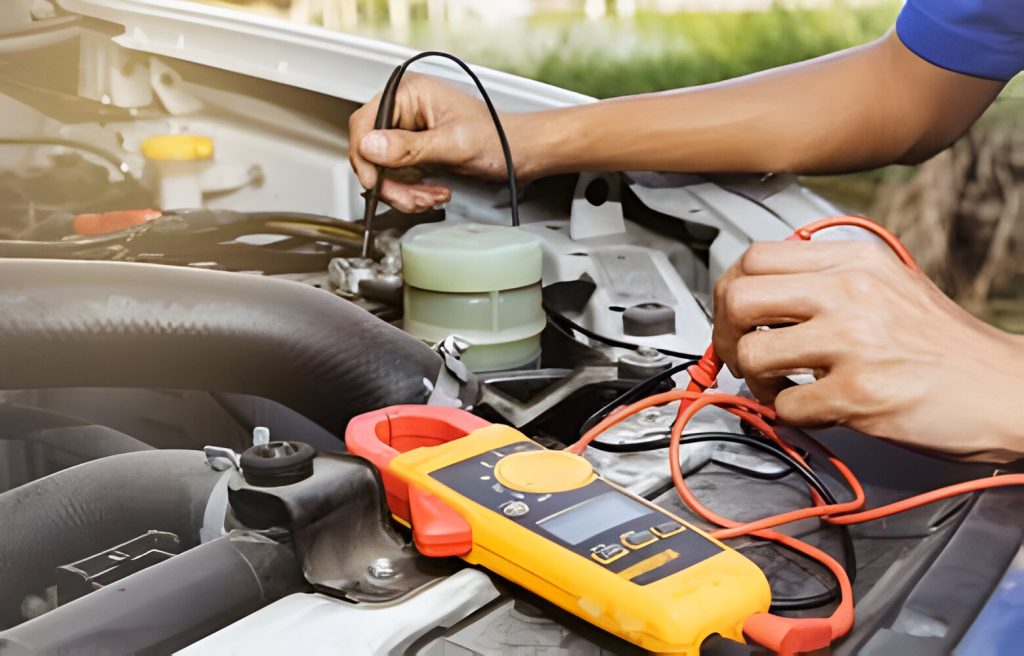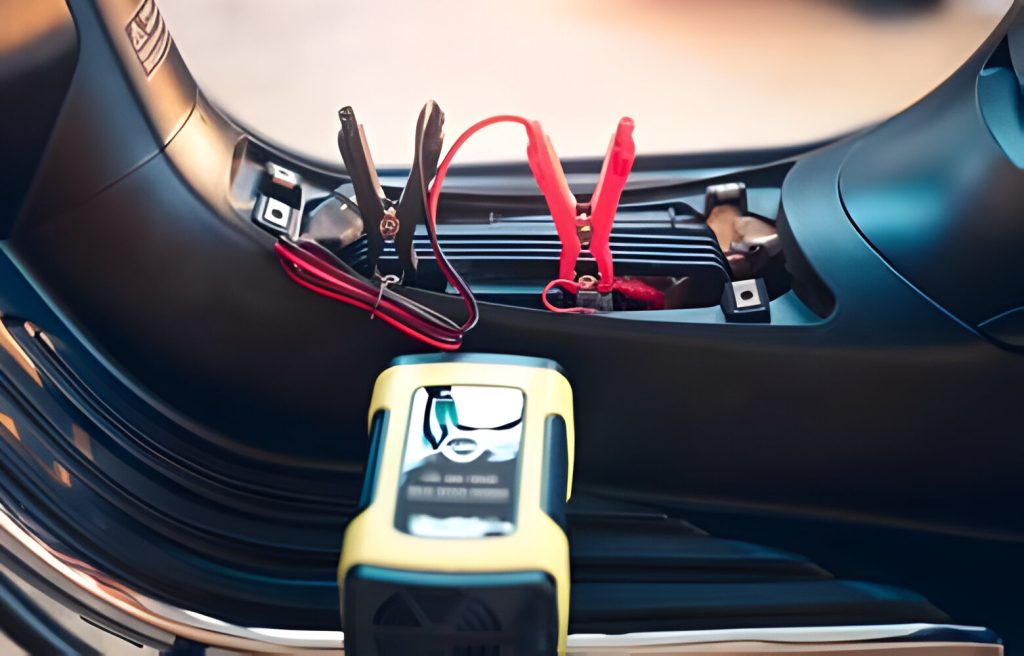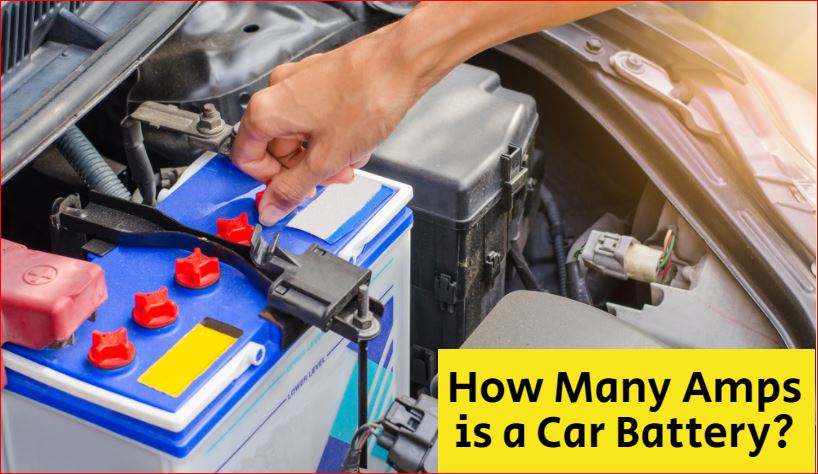A typical car battery has a capacity of around 48 amps per hour. Car batteries usually deliver a 550 to 1000-amp current when starting the engine. Electrifying Force: Unveiling the Surprising Amperage Inside Car Batteries
Understanding the amperage of a car battery is crucial for vehicle maintenance and troubleshooting. These power units are essential for starting the engine and providing energy to electrical components when the alternator can’t. The ampere rating, often abbreviated as “Ah,” indicates how much current a battery can supply over a specific period.
While the cold cranking amps (CCA) measure the battery’s starting power, the amp-hour rating reflects its storage capacity. This knowledge assists car owners in selecting the correct battery and helps prevent unexpected breakdowns. Ensuring a battery’s health keeps vehicles running smoothly and reduces the risk of getting stranded due to power issues.

How Many Amps Are in a Car Battery?
A standard car battery, typically found in vehicles that use internal combustion engines, is 12-volt. However, when people ask about the amps in a car battery, they often refer to two figures: Cold Cranking Amps (CCA) and ampere-hours (Ah). CCA measures the battery’s ability to start a car at 0°F, indicating how much electrical power the battery can deliver for 30 seconds without dropping below 7.2 volts.
A common range for this is between 400 to 600 CCA for most passenger vehicles. On the other hand, ampere-hours represent the battery’s capacity, or how much charge it can hold, commonly between 40 to 60 Ah for car batteries. This indicates how long the battery can deliver a set amount of current (amps) before requiring a recharge.
Introduction To Car Battery Basics
Under the hood of every car lies a vital component – the car battery. This power source is key to starting the engine and keeping electronics running. Understanding its basics is essential for every driver.
The Role Of Amps In Car Batteries
Amps measure the electric current flowing from the battery. They power the starter motor, lights, and other accessories. A healthy car battery should provide ample amps to meet your vehicle’s demands.
Comparing Battery Sizes And Power
Different cars need different battery sizes. The power of a battery is often shown in amp-hours (Ah). It shows how long a battery can deliver a certain number of amps. For example:
| Battery Size | Amp-Hours (Ah) | Typical Use |
|---|---|---|
| Small Car | 40-60 Ah | Light electrical needs |
| Sedan | 60-80 Ah | Moderate accessories |
| Truck/SUV | 80-100 Ah | Heavy-duty demands |
Selecting the right battery size ensures your car performs reliably.
Measuring Electrical Charge
Measuring Electrical Charge in car batteries is essential for understanding their performance. A car battery’s ability to start an engine and power accessories depends on its electrical charge.
Ampere: The Unit Of Electrical Current
The ampere, often shortened to “amp,” is the standard unit for measuring electrical current. It symbolizes how electrons go via a conductor. The number of amps in a car battery indicates the current it can deliver.
Relationship Between Amps, Volts, And Watts
Understanding the relationship between amps, volts, and watts is crucial. Volts measure electrical force, while watts indicate power. This relationship is critical to knowing a battery’s capacity to do work.
To calculate watts, use the formula:
Watts = Amps × Volts
| Component | Function |
|---|---|
| Amps | Current flow |
| Volts | Electrical force |
| Watts | Power output |
- The standard voltage of an automobile battery is 12 volts.
- The amps can vary depending on the battery.
- Higher amps mean more power to start the engine.
By measuring these units, you can determine a battery’s ability to perform under various conditions. Choose a battery with the proper amps to ensure your car runs smoothly.

Typical Amperage In Car Batteries
Understanding the amperage of car batteries is essential for vehicle maintenance. The amperage reflects the electrical power capacity of the battery. This capacity is critical for starting the engine and powering electronic devices in the car.
Average Amps For Standard Vehicles
Standard vehicles typically use batteries with an amperage range of 550 to 1000 amps. This amperage is enough to start the car and run basic electronics.
- Compact cars often have batteries around 550 to 650 amps.
- Sedans and mid-size vehicles usually require between 600 to 750 amps.
- Large SUVs and trucks may need batteries rated for 750 to 1000 amps.
How Battery Size Influences Amperage
The size of a battery can influence its amperage capacity. Bigger batteries tend to have higher amperage ratings. This is because they have more lead plates, increasing electrical output.
| Vehicle Type | Battery Size (Group) | Typical Amps |
|---|---|---|
| Compact Cars | Group 47, 51, 51R | 500-650 Amps |
| Sedans/Mid-Size | Group 24, 24F, 34, 35 | 600-750 Amps |
| SUVs/Trucks | Group 65, 75, 78 | 750-1000 Amps |
Remember, choosing the correct amperage is key for your vehicle’s performance. Refer to the owner’s manual for the recommended battery size and amperage.
Cold Cranking Amps Explained
Cold Cranking Amps Explained helps you understand how powerful your car battery is in cold conditions. It shows how well your battery can start an engine when cold.
Understanding Cca In Vehicle Batteries
The rating known as Cold Cranking Amps (CCA) indicates how well a battery can start an engine in low temperatures. It measures the number of amps a battery can support for 30 seconds at 0 degrees Fahrenheit while maintaining at least 7.2 volts. This rating is crucial because it ensures that your car will start reliably in cold weather.
CCA Ratings And What They Mean For Your Car
Here are critical points about CCA ratings:
- A higher CCA rating means a better cold weather performance.
- Most passenger vehicles require a battery with a CCA rating suitable for their engine size and local climate.
Choosing the proper CCA rating is essential:
- Check your vehicle’s manual for the recommended CCA rating.
- Consider your climate; colder areas might need batteries with higher CCA.
Select a battery that matches or exceeds the recommended CCA rating for optimum cold-weather performance.
Deep Dive Into Battery Specifications
Understanding car battery specifications is crucial for vehicle maintenance. Car batteries are complex components. Their specs reveal their capabilities. This guide helps car owners understand these specs.
Reading The Label: Decoding Battery Terms
Car batteries come with labels filled with codes and terms. To select the right battery, one must decode these terms.
- CCA (Cold Cranking Amps) – Power to start a car in cold weather.
- CA (Cranking Amps) – Power to start a car at 32°F (0°C).
- RC (Reserve Capacity) – Minutes a battery can deliver power without charging.
Amp-hours (ah) And What They Tell Us
Amp-hours (Ah) measure battery capacity. It tells how much current a battery can provide over time. Let’s decipher what Ah means for car batteries.
| Capacity (Ah) | Usage |
|---|---|
| 45-50 Ah | Small cars |
| 50-65 Ah | Mid-sized vehicles |
| 65-100 Ah | Large vehicles, SUVs |
Choose a battery with the proper Ah rating. It ensures your vehicle has enough power to start and run accessories for extended periods.

Credit: www.electronicshub.org
Factors Affecting Battery Amperage
Understanding your car battery’s amperage is crucial for optimal performance. The amperage can vary due to several factors. Let’s explore these influences in detail.
Impact Of Temperature On Battery Performance
Temperature plays a significant role in your car battery’s efficiency. Cold weather can cause a drop in amperage, while hot temperatures may increase discharge rates. Batteries can only function in a specific temperature range. Outside this range, you may notice:
- Slower chemical reactions at low temperatures
- Faster chemical reactions at high temperatures
- Reduced battery lifespan in extreme conditions
The Effect Of Age And Usage On Battery Capacity
A battery’s ability to keep a charge decreases with age. Frequent use and charging cycles also impact its performance. Older batteries often show:
- Lower maximum amperage
- Increased charging times
- Reduced efficiency in energy delivery
Regular maintenance and checks can help maximize battery life and maintain amperage levels.
Testing Your Car Battery’s Amperage
Testing Your Car Battery’s Amperage is crucial for maintaining vehicle health. A car battery’s amps reveal its ability to start the engine. Knowing how to test this can save time and prevent vehicle issues.
Tools For Measuring Battery Amps
Before testing your car battery, gather the right tools:
- Multimeter – Measures voltage, current, and resistance.
- Battery load tester – Provides a more accurate reading of the battery’s health.
- Protective gloves – Ensures safety from electrical hazards.
Step-by-step Guide To Testing Battery Health
- Turn off your car. Ensure all lights and the radio are off, too.
- Connect the multimeter. Attach the red lead to the positive terminal and black to the negative.
- Set to DC Amperage. Read your multimeter’s manual to set it correctly.
- Read the measurement. Note the amps displayed; they should match your battery’s specifications.
- Apply a load test. Use the battery load tester if the amps are below standard.
- Interpret the results. If readings are low, consider charging or replacing your battery.
Regularly testing your car battery’s amperage keeps your car running smoothly and efficiently.
Credit: electronics.stackexchange.com
Maximizing Battery Life And Performance
Understanding the amperage of a car battery is vital in enhancing its life and performance. A typical car battery ranges from 550 to 1000 amps in cranking amps, but actual amp hours can vary. Proper maintenance and occasional upgrades are necessary to maximize a car battery’s potential. Let’s explore how to maintain optimal amperage and consider upgrading options for a more robust battery.
Maintenance Tips For Optimal Amperage
Keeping a car battery at its best requires regular attention. Follow these maintenance tips:
- Regularly check the battery’s terminals for corrosion.
- Use a baking soda and water solution to clean the terminals.
- Ensure the battery is securely mounted to prevent vibrations.
- Test the battery’s charge with a voltmeter regularly.
- Drive your car regularly to keep the battery fully charged.
Upgrading Your Battery For Higher Amps
For those needing more power, consider these upgrade tips:
- Choose a battery with higher cold cranking amps (CCA) for better performance.
- Opt for a battery with a larger reserve capacity (RC) for longer-lasting power.
- Consider batteries designed for extreme conditions if you frequently face them.
- Consult a professional to find the best fit for your vehicle’s needs.
Troubleshooting Common Battery Issues
Troubleshooting common battery issues is essential for car maintenance. A car’s performance hinges on a reliable battery. Knowing how to spot and fix battery problems is critical. This section dives into signs of low amperage and weak batteries. It also highlights when to seek professional help.
Signs Of Low Amperage And Weak Batteries
Understanding the symptoms of a failing battery helps prevent car troubles. Low amperage indicates a battery struggling to perform. Here are signs to watch for:
- Slow Engine Crank: It takes longer for the vehicle to start.
- Dim Lights: Headlights or interior lights appear weaker than usual.
- Warning Lights: The dashboard displays the battery or check engine light.
- Corrosion: A white, ashy material on the battery’s metal components.
- Swollen Battery Case: The battery case may bulge due to overcharging.
When To Seek Professional Battery Services
DIY fixes work for minor issues, but some problems need an expert. Seek professional services in these situations:
- After Jump-Starts: If your car needs frequent jump-starts, check the battery.
- Age: Batteries older than three years may need a check-up or replacement.
- Inconsistent Performance: When battery issues affect the car’s reliability.
- Electronic Issues: Faulty electronics suggest potential battery problems.
A professional can test the battery’s amperage and overall health. They can also advise on a suitable replacement if needed.

Credit: haynes.com
The Future Of Car Batteries
Car batteries have long been a staple in the automotive world. Yet, their future holds revolutionary changes. With technology soaring, the amps in a car battery might look different soon.
Advancements In Battery Technology
The next generation of car batteries promises more power and longevity. Here’s what’s on the horizon:
- Solid-state batteries: They offer higher energy density and safety.
- Lithium-ion improvements: Enhancements in chemistry and design could lead to more amps.
- Graphene batteries: This material could revolutionize battery capacity and charging times.
Predicting Changes In Amperage Needs
As cars become more competent, amperage needs will rise. Predicting these needs is key to development.
| Vehicle Type | Current Amps | Future Amps (Estimate) |
|---|---|---|
| Electric Vehicles (EVs) | 40-60 Amps | 80-100 Amps |
| Hybrids | 30-50 Amps | 60-80 Amps |
| Internal Combustion Engines (ICEs) | 50-70 Amps | 70-90 Amps |
These changes will shape the car battery industry. They will lead to more powerful and efficient vehicles.
Frequently Asked Questions
How Many Amps Are In A 12 Volt Car Battery?
A 12-volt car battery typically ranges from 40 to 60 amp-hours, with the actual amperage varying based on the battery’s size and design.
Is A Car Battery 12 Amp Or 2 Amp?
A car battery typically has a capacity of around 48 amp hours, not just 12 or 2 amps. It delivers a high starting current of about 12 volts.
How Many Amps Does A Battery Need To Start A Car?
A car battery needs 400 to 600 amps to start a car engine.
How Many Amps Should A Car Battery Draw When Off?
When the car is off, a car battery should typically draw less than 50 milliamps (0. 05 amps). This small current maintains essential functions like the clock and security alarms.
Conclusion
Understanding the amperage of your car battery is crucial for maintaining your vehicle’s health. Typically, car batteries range from 45 to 100 amps. Always consult your manual for specific details and consider professional advice for optimal performance. Remember, the proper knowledge ensures a longer life for your car’s battery.

I am a battery specialist writer and blogger based in the USA & UK . I have been working with battery power energy for 3 long years and I give trips on low battery power problem and solutions . I have a lot of experience with battery power and I share them here.
